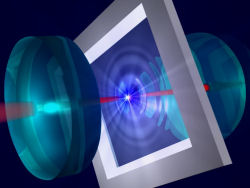Schrödinger’s Drum
Schrödinger’s cat, that miserable feline trapped in a quantum combination of life and death, may never exist. But according to theoretical papers in the 14 November Physical Review Letters and the Rapid Communications section of the October Physical Review A, it should soon be possible to explore the weird effects of quantum mechanics with a different sort of macroscopic object–a drum-like reflective membrane vibrating in an optical cavity. The researchers showed that with current technology, experimentalists should be able to cool a pair of such membranes to a state in which they act like a two-atom molecule, or to an entangled state–a quantum condition in which measurements on one instantly generate effects on the other.
Weird quantum behavior is common for electrons and molecules but not for macroscopic objects. Researchers would like to see the transition from quantum to classical behavior by demonstrating quantum effects in the largest objects possible, particularly systems where a solid object vibrates or wobbles. Oscillating springs or pendulums, for example, should in principle have a ground state–a minimum oscillation amplitude–and a quantized set of allowed amplitudes, like the energy levels of an atom. Perhaps the strangest quantum prediction is that two objects can become “entangled,” locked together in a single quantum state where one influences the other, no matter the distance between them, which Einstein derisively called “spooky action at a distance.”
In March, Jack Harris and his colleagues from Yale University reported experiments using a 7-centimeter-long optical cavity with mirrors on both ends [1]. In the middle of the cavity they suspended a 1-millimeter-square membrane made of a 50-nanometer-thick layer of silicon nitride. The membrane had a partially reflective surface and was free to vibrate. Harris’s team attempted to cool the membrane close to its ground state by shining a laser into the cavity. The barrage of photons reflecting off the mirrors and membrane reduced its motion and cooled it to an effective “vibrational” temperature of 7 millikelvin–a factor of 10,000 below its starting temperature but not quite yet to the quantum limit.
In Physical Review A, Mishkat Bhattacharya and Pierre Meystre from the University of Arizona in Tucson now take this system one step further and show theoretically that a pair of such membranes can effectively form molecule-like states. They begin by writing down the equations that govern the motion of two membranes placed symmetrically about the center of a cavity. Because both membranes are interacting with the laser photons, they are effectively coupled together, like two blocks connected to each other by a spring and to outside walls with one additional spring each. The result is two different modes of motion with two different resonant frequencies–the “center of mass” mode, where the two membranes move back and forth in tandem, and the “breathing” mode, where the two membranes move in opposition to one another.
After feeding in realistic experimental parameters, the researchers find that each of these two modes can be cooled down individually by shining in the correct laser frequency. These frequencies work because the membranes have become coupled through the cavity photons. In effect, the two membrane “atoms” have bonded to act like a single “molecule,” according to the calculations, and it should be possible to cool the molecule’s vibrations close to its ground state.
Michael Hartmann and Martin Plenio of Imperial College London show in Physical Review Letters that it should also be possible to generate long-lived entanglement between two membranes. In their scenario, the membranes are located asymmetrically about the center of the cavity, which results in different modes of vibration. The team calculates what happens when both of their modes are cooled down simultaneously with light from two lasers.
By carefully choosing the laser frequencies, they find that, as the modes cool, the interactions between them are just right to put the membranes into an entangled state that lasts as long as the lasers are on. To verify the entanglement without destroying it, two more weak lasers can be used to probe the membranes.
Steven Girvin of Yale, who worked with Harris on membrane cooling, thinks both of these schemes should be tested in the laboratory in the near future with already-existing technology. “This is quite a rich system that should yield some novel dynamics,” he says.
–Michelangelo D'Agostino
Michelangelo D’Agostino is a physicist and freelance science writer in Berkeley, California.
References
- J. D. Thompson et al., “Strong Dispersive Coupling of a High-Finesse Cavity to a Micromechanical Membrane,” Nature (London) 452, 72 (2008)





